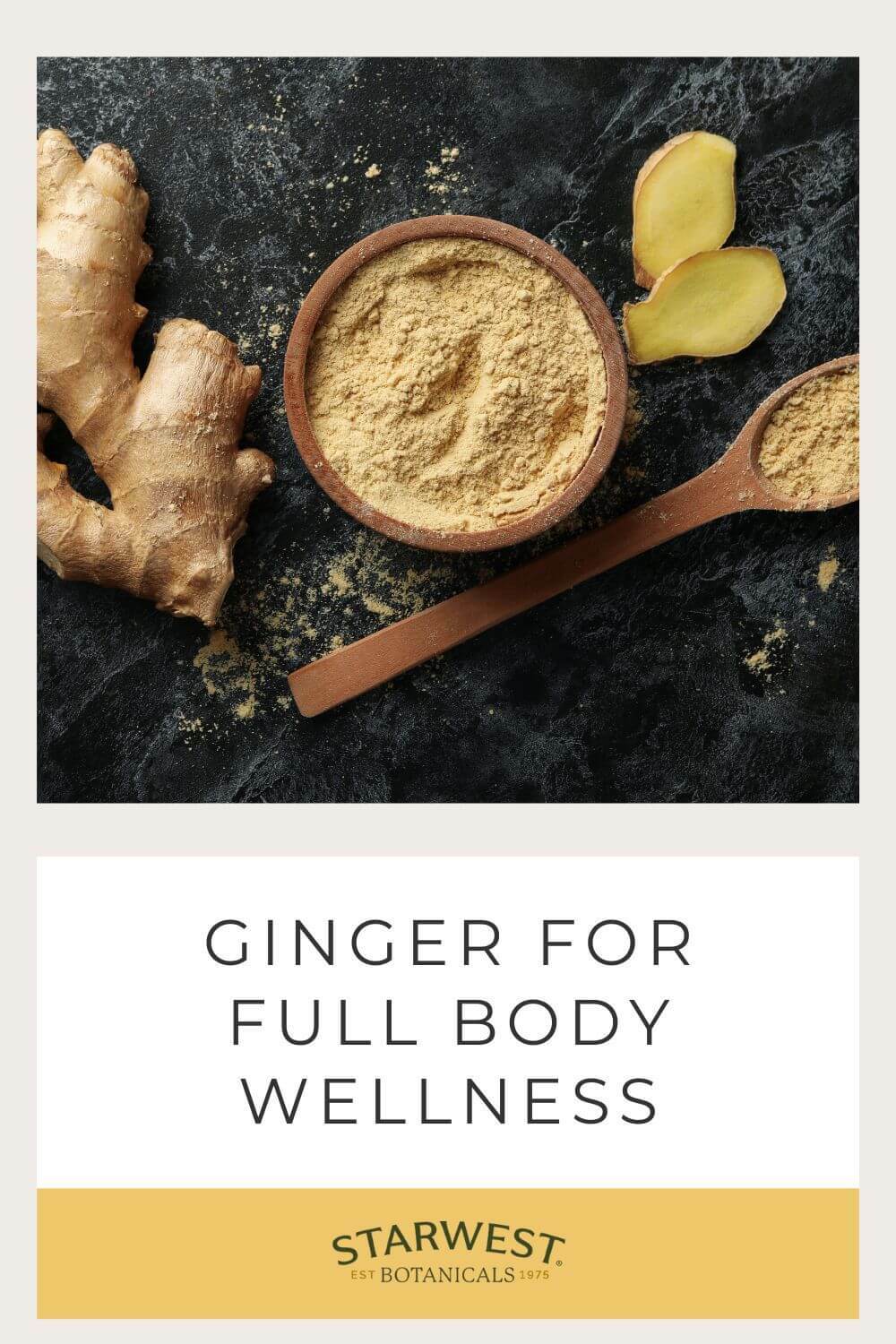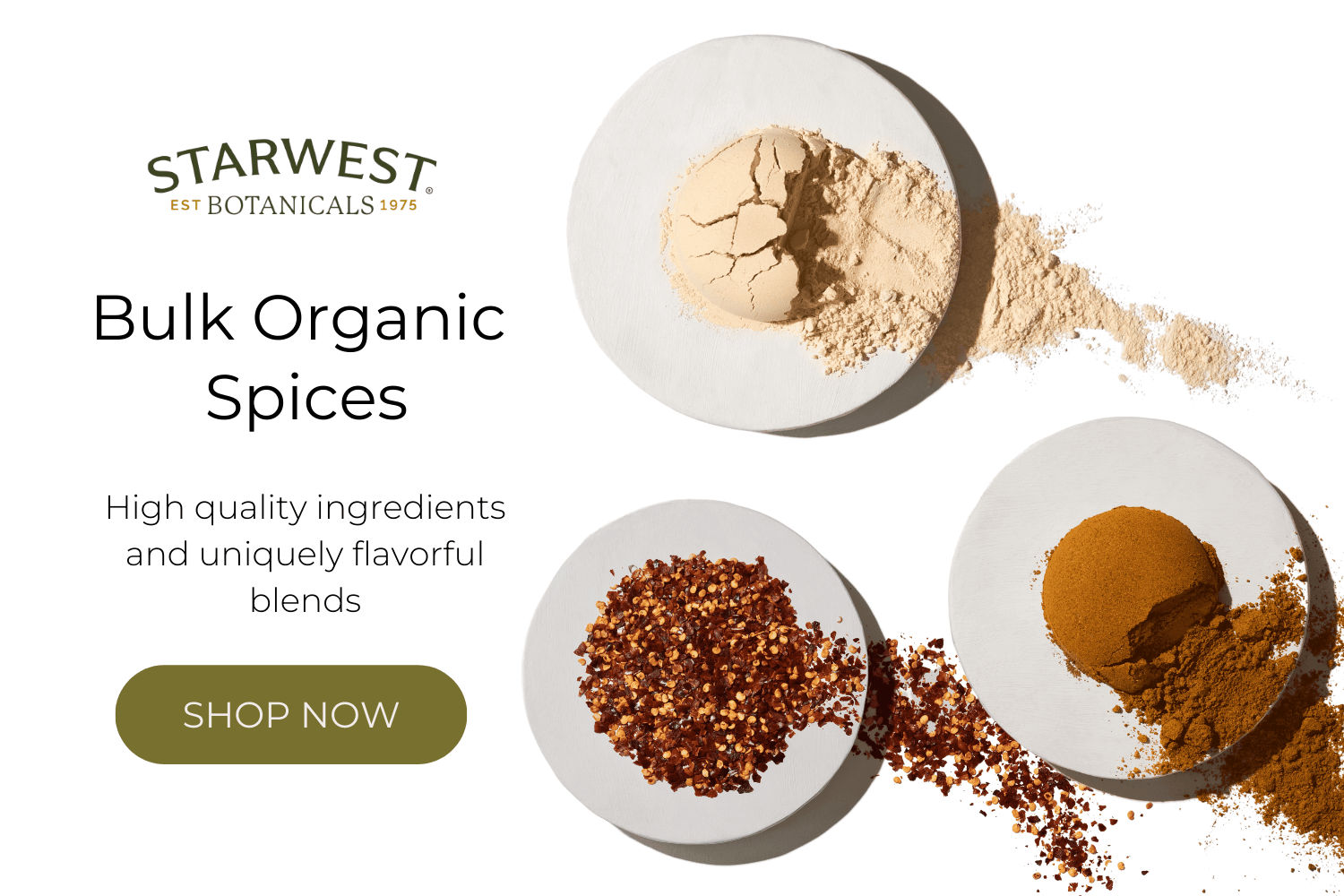Ginger for Full Body Wellness
Posted by Molly McConnell on 03-18-2024

Ginger: The “Great Medicament”
Scientific research is reinvigorating curiosity around centuries-old traditional herbs by shedding light on the naturally occurring compounds that may be responsible for their health-promoting benefits. Ginger is a classic example of an herb that has been prized for its potential therapeutic benefits, in addition to being a common feature in culinary preparations.
Ginger has been widely used by Indian and Chinese physicians for thousands of years. Within the healing science of Ayurveda, ginger is referred to as the “Great Medicament” — or vishwabhesaj, which can also be translated to “The Universal Medicine” — in honor of its vast array of possible health-supporting properties.
You may have known people to chew on ginger when they seek to ease nausea or to sip ginger tea when trying to ward off a seasonal sickness. An Ayurvedic Practitioner may recommend it be applied topically to the temples to help relieve tension of the head. Additionally, ginger is considered to be a sattvic herb, which means it neither agitates the mind nor creates dullness in the body — a perfect middleground for those seeking higher spiritual states. This sattvic quality is what makes ginger a common ingredient in the yogi diet.
Ginger comes in several different forms, the main three being: powdered ginger, cut/sifted dry ginger, and fresh ginger. All three versions of ginger are all derived from the rhizome of the plant, or the root. While the leaves and flowers of a ginger plant are beautiful, most of the nutritive and beneficial potency lies beneath the soil in the root itself.
The Ayurvedic Perspective on Ginger
In Sanskrit, ginger has two different names. It is called sunthi when it’s dry (like in powder form) and ardaka when it’s fresh and moist (straight from the root). Ayurveda classifies ginger as pungent, which is another word for spicy. It is also said to embody the sweet tastes and have a heating effect on the body. Have you ever noticed that you feel warmer after drinking ginger tea? That’s not just because the tea is warm in temperature, it’s also because of the heating action that ginger has within the body. Drinking a ginger kombucha or another ginger-based beverage will likely have a similar effect.
The heating and spicy qualities of this herb are what make it balancing for both vata* and kapha doshas, both of which are otherwise cool in nature. (Vata represents the air and ether elements within us, while kapha represents the earth and water elements within us.)
If used in excess, ginger can increase pitta dosha, which already has a heating quality on its own. Fresh ginger is considered to be more mild, and therefore is better for those with a pitta constitution. (Pitta represents the fire element within us.) We all embody aspects of vata, pitta, and kapha within us, so your needs around which herbs will be most balancing can change from day to day, month to month, or season to season.
*If the terms vata, pitta, and kapha are new to you, that’s ok! These are the three doshas, or functional principles of Ayurveda. They help us understand the qualities of our health challenges based on the wisdom of the elements (earth, water, fire, air and ether). People with lots of vata embody more qualities of air and space (like creativity, adaptability and enthusiasm …but also anxiousness, restlessness and bloating). People with lots of pitta embody more qualities of fire (like passion, discernment and focus …and also irritability, burnout and IBS). People with lots of kapha embody more qualities of earth and water (like patience, generosity and calmness …but also sadness, brain fog and lethargy). To learn more about how vata, pitta and kapha are showing up in your body, take the Dosha Quiz.
Potential Benefits of the Simulating Quality of Ginger
Ayurvedic wisdom asserts that ginger can have an affinity for the digestive and respiratory systems, bringing a stimulating action with it. This is why ginger can be helpful when digestion is feeling sluggish, or when the lungs are cold and damp. Additionally, the stimulating quality of ginger may aid in circulation, bringing warmth, energy and invigoration to your entire being.
This well-loved root forms the basis for many classical Ayurvedic remedies that are still used today — especially when it comes to immune support and seasonal ailments. Multiple scientific studies have shown that ginger may exhibit antioxidant activity.
In The Yoga of Herbs, Dr. David Frawley reminds us that ginger has the potential to help relieve gas and cramps in the abdomen, while also acting as a tonic for the heart. This vibrant root may also be beneficial for joint health and menstrual discomforts. Due to its heating nature, ginger should be avoided in cases of inflammatory skin conditions, high fever, and bleeding ulcers.
How to Use Ginger
Ginger can be used fresh or dry in culinary preparations or natural remedies. It can easily be added to soups, porridges, teas and tonic. I personally love it on tofu and in my evening golden milk.
Dry ginger is said to be more stimulating — especially when it comes to relieving excess kapha (earth and water), breaking up excess mucus, and increasing agni (digestive fire). Fresh ginger is believed to bring extra warmth to the body that may induce beneficial sweating to aid seasonal ailments or excess vata (air and space) in the body.
For kapha dosha, take dry ginger with honey. For vata dosha, take fresh ginger with mineral rock salt. For pitta, take fresh ginger with jaggery (an unprocessed, mineral-rich sugar).
Regardless of your dosha, ginger has a range of potential full body benefits. Consider weaving it into your everyday wellness routine and see what happens.

Molly McConnell is a Certified Ayurvedic Practitioner who is committed to cultivating collective wellness. Guided by curiosity, embodied listening, and the rhythms of nature, Molly’s approach to Ayurveda is intentional and intersectional. As the cofounder ofCultivate Balance, she supports purpose-oriented people to come home to their bodies and restore resilience through nourishment, ritual, and routine. For a more immersive experience,Connect with Molly 1:1 or check outThe Reset for Resilience.



